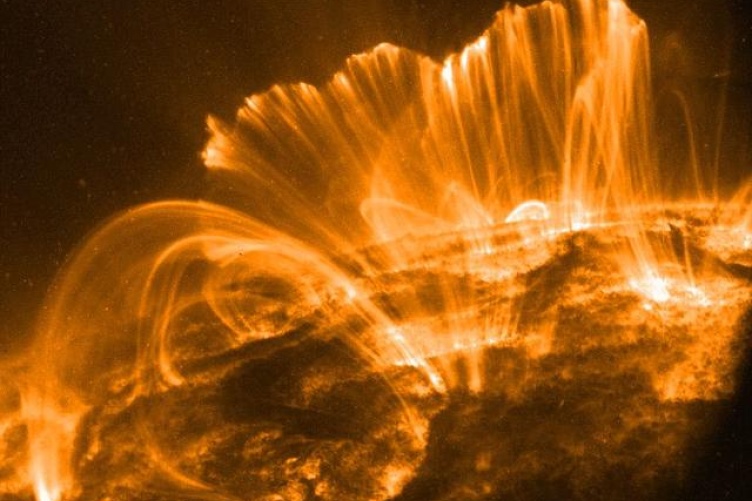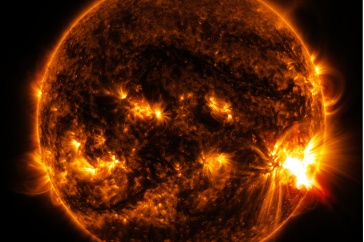
Credit: NASA/GSFC/TRACE
The Earth’s atmosphere plays a larger role in the creation of space storms than previously thought, according to new research from UNH and Nagoya University in Japan.
The study, published in Nature Communications, focuses on the importance of the ionosphere — a region of high concentration of ions and free electrons in the upper atmosphere — in the development of geomagnetic storms that disrupt radio signals, GPS, satellite communications and power grids here on Earth. These findings will ultimately help scientists to improve their predictions of space storms to protect these technologies.
Lynn Kistler, UNH physics professor and director for the UNH Space Science Center, was the lead author on the study; she is also currently serving as a designated professor at Nagoya University. Chris Mouikis, research associate professor in the UNH Space Science Center, was among the study’s co-authors.
“Overall, our research contributes to understanding the development of geomagnetic storms by showing the importance of Earth’s ionospheric plasma,” Kistler says. “We found compelling evidence that plasmas from not only the sun but also the Earth drive a geomagnetic storm.”
"We found compelling evidence that plasmas from not ony the sun but also the Earth drive a geomagnetic storm."
Scientists have long known that geomagnetic storms are associated with the activities of the sun. Hot charged particles make up the sun's outer layer, the one visible to us. These particles flow out of the sun, creating the solar wind and interacting with objects in space, including the Earth. When the particles reach the magnetic field surrounding our planet, known as the magnetosphere, they interact with it; the interactions between the charged particles and magnetic fields lead to space storms.
An important part of the magnetosphere is the magnetotail. The magnetotail is the part of the magnetosphere that extends away from the sun, opposite the direction of the solar wind. Inside the magnetotail is the plasma sheet region, which is full of charged particles (or plasma). The plasma sheet is important because it is the source region for the particles that get into the inner magnetosphere, creating the current that causes geomagnetic storms.
The researchers aimed to solve the mystery of how much of the plasma in the magnetosphere comes from Earth and how that contribution changes during a geomagnetic storm. For their study, they used data from a large geomagnetic storm that happened on September 7-8, 2017. At this time, the sun released a massive coronal mass ejection that collided with the Earth's atmosphere, resulting in a huge geomagnetic storm. The impact disrupted the magnetosphere, leading to interference with radio signals, GPS, and precision timing applications.
The researchers retrospectively analyzed the ion transport during this event using data from several space missions, including the NASA Magnetospheric Multiscale mission, the Japanese Arase mission, the ESA Cluster mission, and the NASA Wind mission. They distinguished the ions from those of the solar wind and from those of the ionosphere itself.
They found that the properties of the plasma sheet, such as density, particle energy distribution, and composition, affected the geomagnetic storm. Using simultaneous measurements of the solar wind composition to track the source changes, they identified substantial changes in the composition of the near-earth plasma sheet as it developed. At the start of the main phase of the storm, the source changed from solar wind dominated to ionosphere dominated.
“The most important discovery was that at the beginning of the geomagnetic storm, the plasma changed from mostly solar to mostly ionospheric,” Kistler explains. “This shows that the geomagnetic storm drives more outflow from the Earth’s ionosphere, and that the ionospheric plasma can move quickly throughout the magnetosphere. In short, the properties of the plasma sheet (the density, the particle energy distribution, the composition) will affect geomagnetic storms, and these properties are different for different sources.”
Funding for the UNH portion of this research was provided by NASA.
The UNH Institute for the Study of Earth, Oceans, and Space (EOS) is UNH's largest research enterprise, comprising six centers with a focus on interdisciplinary, high-impact research on Earth and climate systems, space science, the marine environment, seafloor mapping and environmental acoustics. With approximately 100 principal investigators managing more than 400 individual grant awards, and with annual expenditures exceeding $95 million, EOS fosters an intellectual and scientific environment that advances visionary scholarship and leadership in world-class and graduate education.
-
Compiled By:
Rebecca Irelan | Institute for the Study of Earth, Oceans, and Space | rebecca.irelan@unh.edu | 603-862-0990

















































